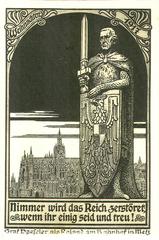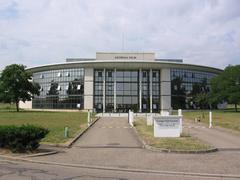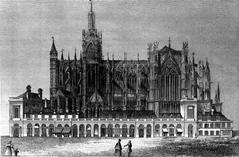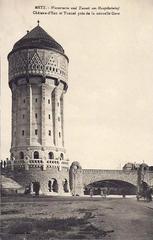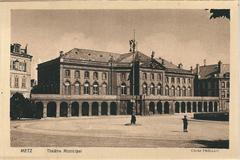
Temple Neuf Metz: Visiting Hours, Tickets & Guide to a Historic Site
Date: 03/07/2025
Introduction
Temple Neuf in Metz, France, is a remarkable testament to the city’s layered history, religious diversity, and vibrant cultural life. Built between 1901 and 1904 during the German annexation of Alsace-Lorraine, it stands as both an architectural landmark and a living cultural hub. With its neo-Romanesque style and strategic riverside location, Temple Neuf offers visitors a unique glimpse into Metz’s Franco-German heritage and serves as a focal point for religious, artistic, and community activities (myCityHunt, France Bleu). This guide provides essential information on visiting hours, tickets, accessibility, and the historical and cultural context of Temple Neuf, ensuring an enriching visit for all travelers.
Table of Contents
- Historical Context and Origins
- Architectural Vision and Features
- Symbolism and Urban Impact
- Survival and Modern Role
- Visiting Temple Neuf: Hours, Tickets & Accessibility
- Cultural Significance and Events
- Nearby Attractions
- Photography Tips and Visual Experience
- Frequently Asked Questions (FAQ)
- Conclusion and Recommendations
- References
Historical Context and Origins
After the Franco-Prussian War (1870–1871), Metz became part of the German Empire, leading to dramatic shifts in its religious and cultural makeup. The influx of German (mostly Protestant) residents prompted the construction of Temple Neuf, a Protestant church designed to serve both as a religious center and a symbol of imperial German presence in a predominantly Catholic city. The project was championed by Kaiser Wilhelm II and executed by architect Conrad Wahn, who drew inspiration from the Romanesque cathedrals of the Rhineland (Cityzeum, France Bleu).
Architectural Vision and Features
Exterior and Style
Temple Neuf’s architecture is a deliberate departure from the local Gothic style and warm Jaumont stone that define Metz, instead utilizing dark grey Vosges sandstone. Its fortress-like design, with five towers (including a central octagonal lantern and two robust western towers), rounded arches, and massive pillars, reflects the neo-Romanesque aesthetic and proclaims its Germanic roots (myCityHunt).
Interior Ambiance
Inside, the church features a cruciform layout, a short nave, broad transept, and semicircular apse. The minimalist decor, elegant arches, and colorful stained glass windows create a serene atmosphere, while the grand German-built organ is prized for musical events (Metz Metropolitain).
Symbolism and Urban Impact
Strategically located on Île du Petit-Saulcy, bordered by the Moselle River, Temple Neuf stands as a visual and cultural counterpoint to Metz Cathedral. Its distinct color and architectural style assert its origins while its riverside setting offers panoramic views and makes it a city landmark. Over time, the church has transformed from a symbol of foreign rule to an emblem of Metz’s resilience, religious plurality, and cultural dialogue (France Bleu).
Survival and Modern Role
Despite its politically charged origins, Temple Neuf survived two world wars and the return of Metz to France. Today, it remains the main Protestant place of worship in the city and has become a hub for cultural and community life, hosting concerts, exhibitions, and interfaith gatherings (Metz Metropolitain).
Visiting Temple Neuf: Hours, Tickets & Accessibility
- Visiting Hours: Generally 9:00 AM to 6:00 PM daily, with possible variations during religious services, concerts, holidays, or special events. Confirm specific times on the Metz Tourist Office website.
- Tickets & Admission: Entry is free for general visits. Some concerts or special events may require tickets or donations (FranceRent).
- Accessibility: The church is wheelchair accessible, with ramps and accessible restrooms. Assistance is available on request.
- Guided Tours: Available by arrangement through the tourist office or during special events. These tours provide in-depth insight into Temple Neuf’s history and architecture.
Cultural Significance and Events
Temple Neuf is a cornerstone of Metz’s religious and cultural life, embodying the city’s commitment to interfaith dialogue. It regularly hosts Protestant worship, inter-religious gatherings, classical concerts, and community events, especially during citywide festivals such as the Fête de la Mirabelle. Its acoustics and welcoming atmosphere make it a preferred venue for musicians and cultural organizations (Metz Metropolitain).
Nearby Attractions
Temple Neuf’s central location on the Île du Petit-Saulcy makes it an ideal starting point for exploring Metz. Nearby highlights include:
- Opéra-Théâtre de Metz: One of France’s oldest working opera houses.
- Place de la Comédie: A scenic public square with cafés and gardens.
- Musée de la Cour d’Or: A museum showcasing Metz’s history and archaeology.
- Jardin d’Amour: Riverside gardens perfect for leisurely walks and photography.
Combine a visit to Temple Neuf with these attractions for a full cultural itinerary (Metz Tourist Office).
Photography Tips and Visual Experience
- Best Views: Capture the church from the Moyen Pont bridge at sunset for dramatic contrasts with the Moselle River and the city skyline.
- Nighttime: Temple Neuf is beautifully illuminated at night, making it a favorite subject for photographers.
- Interior: Morning light enhances the stained glass windows; please avoid flash during services.
- Gardens: The Jardin d’Amour offers peaceful settings for capturing the temple’s exterior and riverside reflections.
Visual resources, including virtual tours and high-resolution photographs, are available on official tourism websites.
Frequently Asked Questions (FAQ)
Q: What are Temple Neuf Metz’s visiting hours?
A: Generally 9:00 AM to 6:00 PM daily; check for variations during special events or services (Metz Tourist Office).
Q: Is there an admission fee?
A: No, general entry is free. Some concerts or events may require tickets or donations.
Q: Is Temple Neuf wheelchair accessible?
A: Yes, with ramps and accessible facilities available.
Q: Are guided tours available?
A: Yes, by arrangement or during special events.
Q: What are the best times to visit?
A: Early evening for illumination, spring and fall for mild weather, and during festivals for cultural events.
Conclusion and Recommendations
Temple Neuf is not only an architectural gem but a vibrant symbol of Metz’s dynamic history, religious coexistence, and cultural vitality. Its imposing neo-Romanesque silhouette, serene interior, and scenic riverside setting make it a must-see for visitors to Metz. Take advantage of free admission, enjoy concerts or community events, and explore nearby attractions for a comprehensive Metz experience.
For current visiting hours, events, and accessibility updates, always check official sources before your visit. Download the Audiala app for curated travel guides, audio tours, and exclusive tips on Metz’s historical sites. Whether you seek history, architecture, or cultural enrichment, Temple Neuf offers a memorable encounter with the spirit of Metz.
References
- Temple Neuf Metz: History, Architecture, Visiting Hours & Tips for Exploring This Iconic Historical Site, 2024, myCityHunt
- Temple Neuf Metz: History and Significance, 2024, France Bleu
- Temple Neuf Metz: Visiting Information and Architectural Highlights of a Historic Landmark, 2024, Cityzeum
- Temple Neuf Metz: Visiting Hours, Tickets, and Cultural Significance, 2024, Metz Metropolitain
- Temple Neuf Metz: Visiting Hours, Tickets, and Guide to This Historic Metz Landmark, 2024, Metz Tourist Office
- Temple Neuf Metz: Preservation and Historical Status, 2024, SpottingHistory
- Temple Neuf Metz: Cultural Events and Guided Tours, 2024, FranceRent









